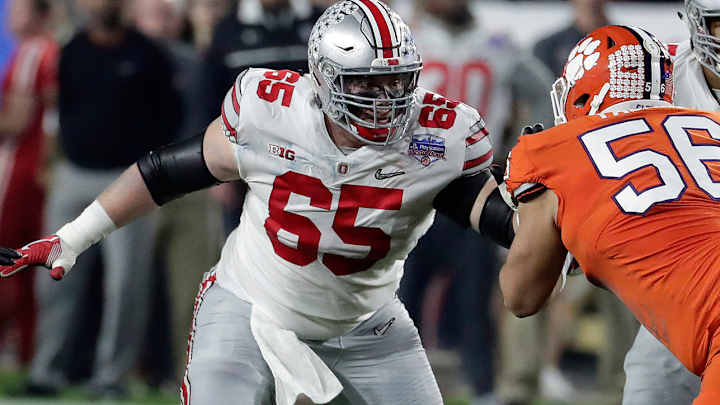2017 NFL draft prospect countdown: No. 40, Ohio State G/C Pat Elflein

What you need to know: The NFL does not see a lot of interior offensive linemen enter its draft early, but Elflein briefly dabbled with that possibility following the 2015 season. He opted to stay in Columbus for his final season, shifted from guard and won the Rimington Trophy as the nation’s top center. Elflein closed his career having started 41 consecutive games for the Buckeyes (28 at guard, 13 at center). He also saw action in every single game after his redshirt year—a string of 55 straight. In addition to his Rimington win, Elflein also was the Big Ten’s Offensive Lineman of the Year in ’16.
Strengths: You know that old adage, “keep your head on a swivel”? This might be the area in which Elflein most excels as a blocker—he constantly has his eyes up, scanning the field for an open defender to engage. Elflein’s awareness makes it almost impossible to sneak a blitzer through a gap near him, and it’s on display when he tracks down opponents at the second (and even third) level on run plays.
He is still learning how to pass protect as a center, having spent just the one season there, but Elflein makes defenders beat him—they aren’t going through him. At 6' 2" and 305-pounds, he anchors well and keeps his hands where they need to be, under his opponents’ shoulder pads; he can lock out defenders and twist them to the ground, and the whistle doesn’t always stop him from doing so. The nastiness is there.
That Elflein can offer an NFL-ready skill set at either guard or center should give him a draft boost. While many interior linemen have experience at both spots, few have excelled the way Elflein did.
Draft This Dude: Why Alabama's Cam Robinson has the potential to be a franchise left tackle
Weaknesses: Elflein is not exactly a missile off the line (his 40-yard dash, three-cone and shuttle times at the combine all were average, even among centers). There still are times where he’d be wise to slow down a bit as he releases upfield on run plays. Too often, he fails to finish those second-level blocks because a defender simply sidesteps his charge. Dialing down the aggressiveness a bit might allow him to connect on more of those attempts.
The opposite problem shows up, on occasion, when Elflein stays at the line: He has to be quicker. Defenders that beat him for QB pressures usually did so with speed, and he struggled when he had to pull from the center spot to pick up a DE or OLB—Clemson had defenders come free off the edge a couple of times against Ohio State in the Fiesta Bowl because of this. His footwork as a center still is proficient enough to thrive in a zone-blocking scheme, but his NFL offense will have to be aware of his early limitations.
NFL player comparison: Max Unger
